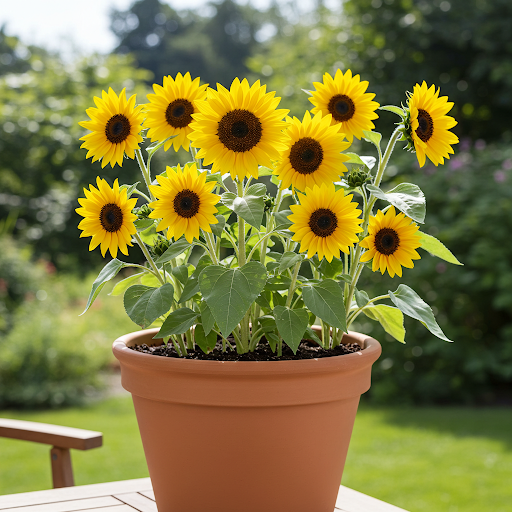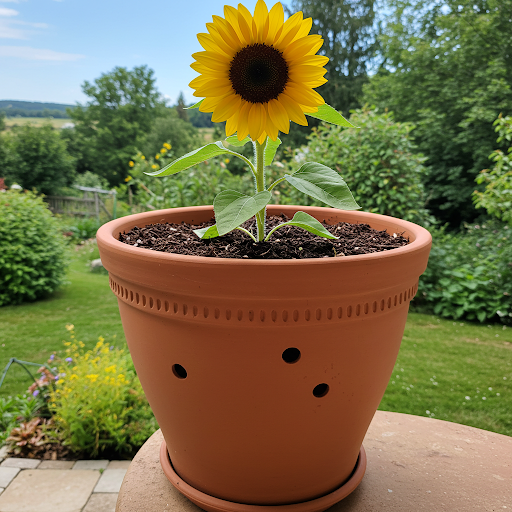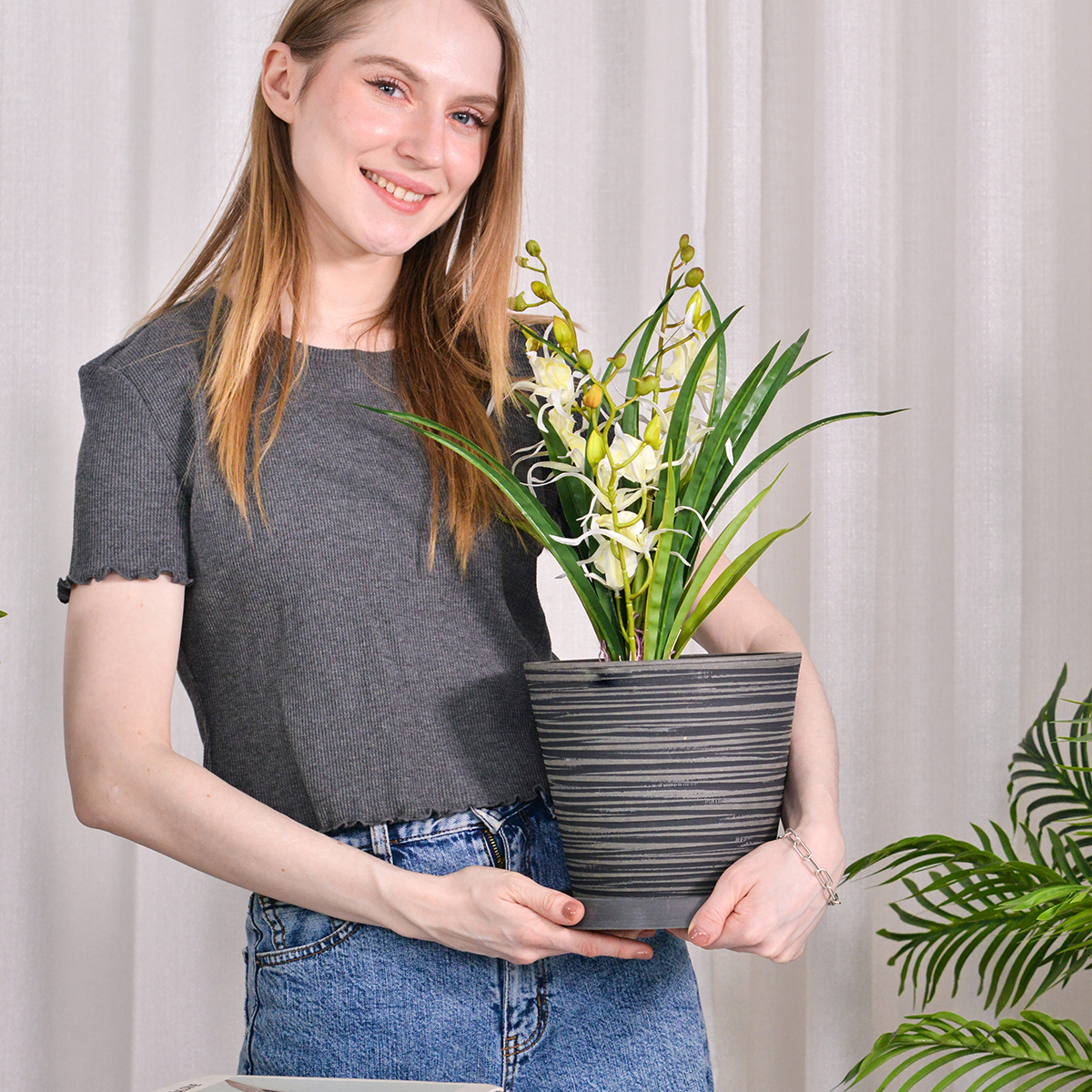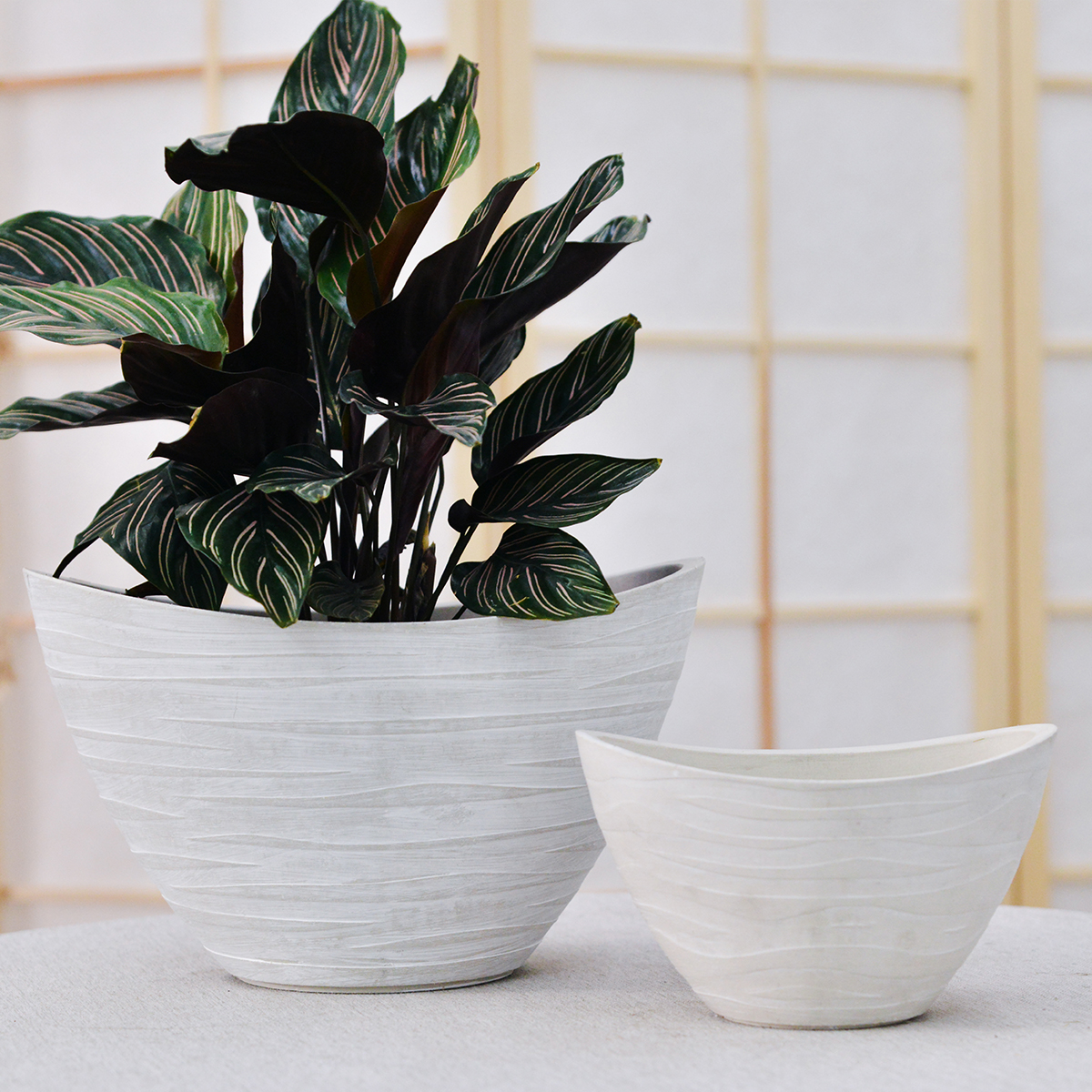Sunflowers in Pots: The Ultimate Guide to Growing Tall & Dwarf Sunflowers in Containers
Want to bring the iconic beauty of sunflowers to your patio, balcony, or small garden space? Sunflowers are a fantastic and surprisingly easy choice for outdoor container gardening. Whether you dream of towering giants or charming dwarf varieties, sunflowers can thrive in pots, bringing their sunny disposition and vibrant color to your outdoor living areas. This comprehensive guide will provide you with everything you need to know to grow sunflowers successfully in outdoor pots, from selecting the best varieties and containers to mastering essential care techniques for a season filled with sunflower joy.

Sunflowers
What are Sunflowers (Helianthus annuus)?
Sunflowers (Helianthus annuus) are iconic annual flowering plants belonging to the daisy family, Asteraceae. Native to North America, sunflowers are celebrated worldwide for their large, radiant, daisy-like flower heads and tall, stately stature. Sunflowers are named for their heliotropism, the unique ability of young flower heads to follow the sun’s movement across the sky. Sunflower flowers are typically large and composite, with a central disk floret area surrounded by bright yellow ray florets (petals), though varieties exist in shades of red, orange, brown, and even cream and white. They are broadly categorized into types based on height and flower size, including Dwarf Sunflowers, Medium Sunflowers, and Tall Sunflowers, as well as various flower forms like single-stem, branching, and pollenless. Sunflowers are cherished for their impressive height, cheerful blooms, edible seeds and oil, and ability to attract pollinators and birds, making them a rewarding and useful addition to any container garden, even in urban settings.
Are Sunflowers (Helianthus annuus) Good for Outdoor Pots?
Yes, Sunflowers (Helianthus annuus) can be successfully grown in outdoor pots, especially dwarf and medium varieties. While traditionally grown in gardens due to their size, many sunflower varieties are now bred specifically for container gardening. Growing sunflowers in pots allows you to enjoy their beauty even in small spaces like balconies, patios, and decks. Container sunflowers bring vertical interest, vibrant color, and a touch of whimsy to any outdoor setting. Choosing the right pot size and sunflower variety is key to success, but with proper care, you can absolutely enjoy the majestic presence of sunflowers in pots.
Ideal Growing Conditions for Sunflowers (Helianthus annuus) in Pots:
- Types of Sunflowers for Pots: While you can technically grow any sunflower in a pot given a large enough container, certain types are much better suited for container gardening due to their size and growth habit. Consider these excellent sunflower types for pots:
- Dwarf Sunflowers: (e.g., ‘Teddy Bear’, ‘Elf’, ‘Little Becka’, ‘Sunny Smile’) – Compact and bushy, typically reaching 1-3 feet tall, perfect for small to medium-sized pots. Known for their manageable size, early blooming, and suitability for limited spaces. Excellent for patios, balconies, and as centerpieces in mixed container arrangements.
- Medium Sunflowers: (e.g., ‘Sundance Kid’, ‘Chianti Hybrid’, ‘Autumn Beauty’) – Reach 3-5 feet in height, offering a good mid-range size for larger pots and containers. Provide more substantial height than dwarf types, while still being manageable in pots. Versatile for medium to large pots, and can be used as “thrillers” or focal points in container gardens.
- Tall Sunflowers: (e.g., ‘Mammoth’, ‘Russian Giant’, ‘Skyscraper’) – Can reach towering heights of 6-12 feet or more, best suited for very large, stable containers if you wish to grow them in pots. Provide dramatic vertical impact and truly impressive blooms. May require significant staking and careful container selection to prevent toppling, especially in windy locations. Consider for large patios or garden areas where you want a dramatic statement.
- Pollenless Sunflowers: (Many varieties available in dwarf, medium, and tall types) – Bred to produce minimal or no pollen, making them ideal for cut flowers and for allergy sufferers. Also cleaner for patios and decks as they don’t drop pollen. Look for pollenless varieties within your desired height category.
- Branching Sunflowers: (Varieties available in various heights) – Produce multiple flower heads per plant, rather than a single main bloom. Offer a bushier, more floriferous display and longer blooming period. Good for filling out containers and providing continuous color.
- Light: Sunflowers are sun-worshippers and need full sun to thrive and bloom to their full potential. They require at least 6-8 hours of direct sunlight per day, and ideally even more. Locations with morning sun and afternoon shade can work, but full, all-day sun is best for robust growth, strong stems, and large, vibrant blooms. Insufficient light will result in weak, leggy growth, smaller flower heads, and reduced blooming. Choose the sunniest possible location for your sunflower containers.
- Soil: Sunflowers prefer well-draining soil that is fertile and rich in organic matter. Use a high-quality potting mixspecifically formulated for containers or flowers. Amend potting mix with compost or well-rotted manure to improve fertility and drainage. Avoid heavy, compacted soil or garden soil in pots, as it can become waterlogged. A slightly acidic to neutral pH (around 6.0-7.0) is ideal for sunflowers. Good drainage is crucial to prevent root rot, especially in containers.
- Watering: Sunflowers need consistent moisture, especially when young and actively growing, and when grown in pots. Water deeply and regularly, especially during hot, dry weather. Water thoroughly when the top inch of soil feels dry. Water deeply until water drains out of the drainage holes. Allow the very top surface of the soil to slightly dry between waterings, but do not let the soil dry out completely, especially during bud formation and flowering. Sunflowers are moderately drought-tolerant once established in the ground, but container-grown sunflowers will dry out more quickly and require more consistent watering. Check soil moisture regularly and adjust watering frequency based on weather conditions, plant size, and pot size. Water at the base of the plant to keep foliage dry and help prevent fungal diseases.
- Temperature: Sunflowers are warm-weather annuals and thrive in warm temperatures. They perform best in temperatures between 70°F to 85°F (21°C to 29°C). They are sensitive to frost and cold temperatures. Plant sunflower seeds or seedlings outdoors after the last frost in your area, and when soil temperatures have warmed up. They thrive in heat and continue to bloom through hot summer weather.
- Fertilizer: Sunflowers are moderate to heavy feeders, especially taller varieties and those grown for seed production. Fertilize monthly or bi-monthly during the growing season to support strong growth and large blooms. Use a balanced liquid fertilizer (e.g., 10-10-10 or 20-20-20) diluted to half strength, or a fertilizer specifically formulated for flowering plants. You can also amend the potting mix with a slow-release fertilizer at planting time. For sunflowers grown for seed production, you can increase phosphorus and potassium levels in the fertilizer during bud formation and flowering to encourage seed development. Avoid over-fertilizing, which can lead to leggy growth and weak stems.
Choosing the Right Pots for Sunflowers (Helianthus annuus):
- Suitable Pot Types: Sunflowers can be grown in various pot types, but stability and drainage are key, especially for taller varieties. Consider these pot types for sunflowers:
- Terracotta Pots: Porous, allow good aeration and drainage, and aesthetically classic. Heavier terracotta pots are good for providing stability for taller sunflowers, but may dry out more quickly, requiring more frequent watering.
- Ceramic Pots: Available in many decorative styles, retain moisture better than terracotta, and can add a decorative element to your container garden. Choose sturdy, heavy ceramic pots for stability, especially for medium and taller varieties. Ensure good drainage.
- Plastic Pots: Lightweight, inexpensive, retain moisture well, available in various colors and styles. Choose good quality, heavy-duty plastic pots that are wide and stable, especially for larger sunflowers. Lighter plastic pots may be suitable for dwarf varieties, but taller types may become top-heavy and prone to tipping in lighter pots.
- Resin Pots: Lightweight, durable, available in various styles mimicking terracotta or ceramic, and retain moisture well. Choose sturdy, wide-based resin pots for stability. Resin pots can be a good balance of weight and moisture retention for sunflowers.
- Metal Containers: Can add a modern or rustic look, and are often sturdy. Metal containers can heat up quickly in full sun, potentially drying out soil faster. Choose larger, wider metal containers for stability, and consider lighter colors to reflect heat. Ensure good drainage.
- Grow Bags: Fabric grow bags are breathable and provide excellent drainage and aeration for roots. Choose large, sturdy grow bags made of durable fabric. Grow bags can be a good option for sunflowers, but may dry out more quickly than solid containers, requiring more frequent watering.
- Avoid Narrow or Top-Heavy Pots: Choose pots that are wider at the base than at the top to provide stability and prevent taller sunflowers from toppling, especially in windy conditions. Avoid narrow, tall pots that can easily tip over.
- Drainage: Excellent drainage is absolutely essential for sunflowers to prevent root rot. Ensure your chosen pot has large drainage holes at the bottom. Avoid pots without drainage holes. Elevating pots slightly on pot feet or bricks can improve drainage and air circulation around the base. Adding a layer of gravel or pot shards at the base of the pot can further improve drainage, especially in very deep pots, but is less critical if using a well-draining potting mix and pots with good drainage holes.
- Pot Size: Pot size is crucial for sunflower success in containers. Choose pot sizes appropriate for the mature size of the sunflower variety you are planting. Too small of a pot will restrict root growth, stunt plant size, and reduce flowering. Too large of a pot can lead to overly wet soil and root rot, especially for dwarf varieties.
- Dwarf Sunflowers: For dwarf sunflowers (1-3 feet tall), pots that are 10-12 inches in diameter and 10-12 inches deep are generally sufficient for individual plants. For multiple dwarf plants, use larger pots or window boxes, spacing plants appropriately.
- Medium Sunflowers: For medium sunflowers (3-5 feet tall), use pots that are 12-18 inches in diameter and 12-18 inches deep for individual plants. Larger pots are better to provide stability and support root growth for these taller varieties.
- Tall Sunflowers: For tall sunflowers (6 feet and taller), use very large, stable containers that are at least 18-24 inches in diameter and 18-24 inches deep, or even larger if possible. Consider using half-barrel planters, large tubs, or sturdy, oversized pots for tall varieties. Stability is paramount for tall sunflowers in pots to prevent toppling.
- Depth: Ensure pots are at least as deep as they are wide, and ideally deeper, to accommodate the taproots of sunflowers, especially for medium and tall varieties.
- Color and Style: Choose pot colors and styles that complement your sunflower blooms and your outdoor décor. Earthy tones like terracotta or warm-colored ceramic pots can enhance the natural, sunny look of sunflowers. Brightly colored pots can create a more vibrant and playful display. Consider using heavier pots in neutral colors for taller varieties to provide stability without distracting from the blooms.
Essential Care Tips for Thriving Sunflowers (Helianthus annuus) in Outdoor Pots:
- Watering: “Water Deeply and Regularly, Keep Soil Moist”. Water thoroughly when the top inch of soil feels dry. Water deeply and regularly, especially during hot, dry weather and during bud formation and flowering. Avoid letting soil dry out completely, but also avoid overwatering and soggy soil.
- Sunlight: Provide Full Sun. Place sunflower pots in a location that receives at least 6-8 hours of direct sunlight daily, and ideally more for optimal growth and flowering.
- Fertilizing: Feed Monthly or Bi-Monthly During Growing Season. Fertilize monthly or bi-monthly with a balanced liquid fertilizer or flowering plant fertilizer to support strong growth and abundant blooms. You can also use a slow-release fertilizer at planting time.
- Staking (For Medium and Tall Varieties – Essential): Staking is highly recommended for medium and tall sunflower varieties grown in pots, especially in windy locations, to prevent stems from bending or breaking under the weight of the flower heads or from wind. Insert sturdy plant stakes or bamboo stakes into the pot near the plant stem at planting time, and tie stems loosely to stakes as they grow taller. Use multiple stakes if needed for very tall or heavy-headed varieties.
- Deadheading (Optional, for Branching Types): For single-stem sunflower varieties, deadheading spent blooms is not necessary as they produce one main flower. For branching sunflower varieties, deadheading faded flowers can encourage more side blooms and extend the flowering period. Pinch or snip off spent flower heads to encourage further blooming on branching types.
- Pest and Disease Control: Sunflowers are generally relatively pest and disease-resistant, but monitor for common pests like aphids, spider mites, sunflower beetles, and snails/slugs. Powdery mildew and rust can occur, especially in humid conditions or with poor air circulation. Ensure good air circulation by spacing plants adequately, avoid overcrowding, water at the base of the plant, and treat any pest or disease issues promptly with insecticidal soap, horticultural oil, neem oil, or appropriate fungicides if necessary. Birds and squirrels may also be attracted to sunflower seeds as they mature; netting may be needed to protect developing seeds if seed harvest is desired.
- Seed Harvesting (Optional): If you wish to harvest sunflower seeds, allow flower heads to mature fully and dry on the plant. Once the back of the flower head turns brown and dry and seeds are plump, cut off the flower head and allow it to dry further indoors. Seeds can then be easily removed from the dried flower head.
Popular Sunflower Cultivars for Pots (by Type):
- Dwarf Sunflowers: ‘Teddy Bear’, ‘Elf’, ‘Little Becka’, ‘Sunny Smile’, ‘Pacino’, ‘Suntastic Yellow with Black Center’
- Medium Sunflowers: ‘Sundance Kid’, ‘Chianti Hybrid’, ‘Autumn Beauty’, ‘Inca Gold’, ‘Valentine’, ‘Terracotta’
- Tall Sunflowers: ‘Mammoth’, ‘Russian Giant’, ‘Skyscraper’, ‘American Giant’, ‘Titan’, ‘Sunzilla’
- Pollenless Sunflowers: ‘Sunrich Series’, ‘ProCut Series’, ‘Soraya’, ‘Apricot Twist’, ‘Lemon Queen’
- Branching Sunflowers: ‘Sonja’, ‘Starburst Lemon Aura’, ‘Moulin Rouge’, ‘Floristan’, ‘Chianti Hybrid’ (can be pinched to encourage branching)
In Summary:
Growing Sunflowers (Helianthus annuus) in outdoor pots is a fun and rewarding way to bring the iconic beauty and sunny cheer of sunflowers to your patios, balconies, and gardens, even in limited spaces. By choosing appropriate dwarf or medium varieties, providing full sun, well-draining potting mix in large, stable pots with drainage, watering deeply and regularly, fertilizing monthly, and staking taller types, you can easily cultivate impressive sunflower displays in pots and enjoy their vibrant blooms, pollinator attraction, and even edible seeds all season long.

Sunflowers
Important Note: Sunflowers (Helianthus annuus) are considered non-toxic to humans and pets, making them a safe and enjoyable choice for households with children and animals. The primary care considerations when growing sunflowers in pots are providing sufficient sunlight, choosing appropriately sized and stable pots, and providing adequate staking for taller varieties. With these simple care practices, you can enjoy a season filled with the towering beauty and sunny charm of sunflowers in your outdoor containers.
HS
By greenship|2024-08-13T06:45:17+00:00August 13, 2024|Categories: Hand-carving Series|
11TH
By greenship|2024-08-13T02:50:25+00:00August 13, 2024|Categories: Hand-carving Series|
K2-11T
By greenship|2024-08-13T04:21:25+00:00August 13, 2024|Categories: Hand-carving Series|
Planter 6 in W / 8 in W / 12 in W Indoor or Outdoor Plants, Modern Decorative Plant Pots with Drainage Hole, Decorative Flower Pots
By greenship-seo|2025-02-06T13:43:53+00:00January 16, 2025|Categories: Hand-carving Series|Tags: Decorative Flower Pots|
KC2-11V
By greenship|2024-08-16T05:39:50+00:00August 16, 2024|Categories: Hand-carving Series|
20YB
By greenship|2024-08-16T05:37:57+00:00August 16, 2024|Categories: Hand-carving Series|






